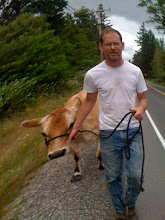The contractors have finished for the day, the workmen gone home. The animals have been fed and watered, the cows milked. The milking parlor has been scrubbed down and the evening milk is cooling is the chiller. Surprisingly no neighbors are running lawnmowers to disturb the calm. All is right with the world.
Dinner this evening was divine and of this place, this terroir. A tranche off a beef rib eye, with a bit of fat on the edge, aged for two weeks. This was from the last calf slaughtered: Bruno, a beautiful calf, the son of Dinah, head cow at Kurtwood Farms. The meat had hung for 14 days before being frozen to dry a bit and concentrate its flavors. I savor those flavors this evening, weeks later.
The steak was sauted on a hot steel pan with a bit of pork fat. It sputtered and popped and browned to the surface of the steel. I flipped it, seared the other side and left it to finish cooking on the heat. The smell of the beef filled the smokey room.
When the steak had the feel and give of a medium rare steak -- saignant, I moved it to my waiting plate to rest. None of that cover it with a sheet of foil stuff, I wanted to see it as I finished the sauce. A few onions went onto the steel pan to add a bit of bite and then a splash of red wine to deglaze and pull those crunchy bits form the pan. A big lump of beef jelly from the cooler sputtered as it melted on the heat. The onions cooked, the stock melted and the sauce began to reduce. A lump of golden Jersey butter finished out the sauce giving it a shine and a luxury that the steak deserved.
The juices from the waiting steak went back into the pan, a final swirl and the sauce graced the large white plate. Cracks of black pepper added some bite to the pretty plate. No prissy garnish, no chopped herbs to mess it, just the brown earthy sauce and the crusty brown beef.
The sun had begun its slow descent by this time to the horizon. The dogs huddled at my feet expecting a piece of beef that would never come. Each bite was savored. Nothing was wasted, all was enjoyed, a scrap of bread licking the sauce left on the plate.
A bowl of rhubarb finished the meal, sweetened a bit but holding onto its sour roots. The red color was disarming, nothing cherry like about this rhubarb. Its classification as a vegetable got me off the hook for not having a salad or a branch of broccoli in sight in spite of a garden filled with greenery a few steps from the kitchen door.
Not a very summery meal on this high holiday of summer. But is was a great meal, one to savor bite by bite while reflecting on the year that has been as we peak and slide down the other side of June.






